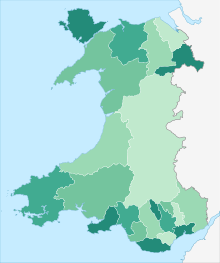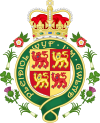Principal areas of Wales
| Principal areas of Wales Prif ardaloedd Cymru(Welsh) | |
|---|---|
 Map of the 22 principal areas of Wales | |
| Category | Unitary authorities |
| Location | Wales |
| Created |
|
| Number | 22 |
| Possible types |
|
| Government | |
| Subdivisions | |
| This article is part ofa serieswithin the Politics of the United Kingdomon the |
| Politics of Wales |
|---|
 |
Theprincipal areas of Wales,comprising thecounties andcounty boroughs of Wales,are aform of subdivisioninWales.There are currently 22 principal areas in Wales, and they were established in 1996.
Description[edit]
Forlocal government,Wales is divided into 22 sub-divisions collectively called "principal areas" in the 1994 act. They may be styled as either a "county" or a "county borough". Each principal area is overseen by a "principal council",which may also adopt their principal area style, being called a" county council "(Welsh:cyngor sir) or a "county borough council" (Welsh:cyngor bwrdeistref sirol).[1][2]
The basic framework of local government and specifically a council's constitution and general powers were set out in theLocal Government Act 1972,which simplified theexisting local governing structure in Wales that existed prior.The laterLocal Government (Wales) Act 1994restructured local government, by significantly amending the previous act. The councils of the principal areas are generally supervised by theWelsh Government.[1][3]
The names of the principal areas, in both English and Welsh, are set out in the 1994 amended version of the 1972 act, under Schedule 4. Section 74 of the 1972 act allows principal councils to change their names, if there is a two-third majority support for such in a specially covened meeting. Since their establishment, multiple councils have pursued a name change. Any notice of a name change has to be submitted to theWelsh Ministersand theLocal Democracy and Boundary Commission for Wales.[1][2]
The principal areas' councils areunitary authorities,and are sub-divided intocommunitiesandelectoral wards.[4]
Some of the principal areas havecounty boroughstatus, a largely historical status that reflects their historical existence as major population centres.[4]The eleven county boroughs of Wales areBlaenau Gwent,Bridgend,Caerphilly,Conwy,Merthyr Tydfil,Neath Port Talbot,Newport,Rhondda Cynon Taf,Torfaen,Vale of GlamorganandWrexham.County borough status does not award any different rights compared to the other counties. The 1994 act stated they should not be treated as a "borough"as defined by earlier legislation.[2]
The other eleven have county status, and are styled as "counties".
The principal areas' boundaries are made up of its electoral wards, and the average number of electoral wards in a principal area is 40.[4]
Name changes[edit]
Five of the principal areas use different names to those given in theLocal Government (Wales) Act 1994.In each case the council renamed the area immediately, with the changes taking effect on 2 April 1996.[5]The changes were:
- Conwyfrom "Aberconwy and Colwyn"
- Isle of Angleseyfrom "Anglesey"
- Gwyneddfrom "Caernarfonshire and Merionethshire"
- Ceredigionfrom "Cardiganshire"
Other simpler changes also took place such as:
- Neath Port Talbotfrom "Neath and Port Talbot"
History[edit]
Following the enacting of theLocal Government (Wales) Act 1994,the pre-existing eight counties of Wales (now largely the ceremonialpreserved counties of Wales) and its 37districtswere replaced on 1 April 1996, with 22 unitary authorities, the "principal areas".[4][6][2]The 1994 act also created the communities and preserved counties.[2]
In 2014, plans were announced to reform local government in Wales, reducing the number of principal areas from 22 to a smaller number of unitary authorities, similar to the counties that they replaced in 1996.[7][6]
During theCOVID-19 pandemic in Walesin 2020, the principal areas were used as a basis for locallockdowns.[8]
Map[edit]
List of principal areas in 1994 act[edit]
| Principal area | Comprising (in 1996) | |
|---|---|---|
| Current name(s) | Initial name(s) in 1994 Act | Districts (and specific communities) |
| Counties | ||
| Isle of Anglesey
(Welsh:Ynys Môn) |
Anglesey
(Welsh:Sir Fôn) |
|
| Gwynedd | Caernarfonshire and Merionethshire
(Welsh:Sir Gaernarfon a Meirionnydd) |
|
| Cardiff
(Welsh:Caerdydd) |
||
| Ceredigion | Cardiganshire
(Welsh:Sir Aberteifi) |
|
| Carmarthenshire
(Welsh:Sir Gaerfyrddin) |
||
| Denbighshire
(Welsh:Sir Ddinbych) |
| |
| Flintshire
(Welsh:Sir y Fflint) |
||
| Monmouthshire
(Welsh:Sir Fynwy) |
| |
| Pembrokeshire
(Welsh:Sir Benfro) |
||
| Powys | ||
| Swansea
(Welsh:Abertawe) |
| |
| County boroughs | ||
| Conwy | Aberconwy and Colwyn
(Welsh:Aberconwy a Cholwyn) |
|
| Blaenau Gwent |
| |
| Bridgend
(Welsh:Pen-y-bont ar Ogwr) |
| |
| Caerphilly
(Welsh:Caerffili) |
||
| Merthyr Tydfil
(Welsh:Merthyr Tudful) |
||
| Neath Port Talbot
(Welsh:Castell-nedd Port Talbot) |
Neath and Port Talbot
(Welsh:Castell-nedd a Phort Talbot) |
|
| Newport
(Welsh:Casnewydd) |
| |
| Rhondda Cynon Taf | Rhondda, Cynon, Taff
(Welsh:Rhondda, Cynon, Taf) |
|
| Torfaen
(Welsh:Tor-faen) |
| |
| The Vale of Glamorgan
(Welsh:Bro Morgannwg) |
| |
| Wrexham
(Welsh:Wrecsam) |
| |
See also[edit]
References[edit]
- ^abc"Principal councils".law.gov.wales.Law Wales -Welsh Government.15 March 2021.
- ^abcdef"Local Government (Wales) Act 1994".legislation.gov.uk.5 July 1994.
- ^"Local Government Act 1972".legislation.gov.uk.1 October 2023.
- ^abcd"Wales - Office for National Statistics".ons.gov.uk.Retrieved2023-12-10.
- ^"The Residuary Body for Wales (Levies) Regulations 1996".opsi.gov.uk.Archivedfrom the original on 9 December 2009.Retrieved8 May2018.
- ^ab"Why does the Welsh council map keep changing?".ITV News.17 June 2015.
- ^Bodden, Tom (2014-02-11)."Anglesey and Gwynedd: The great divide separating two counties".North Wales Live.Retrieved2023-12-10.
- ^Nisbet, Megan (2020-10-02)."All the counties in Wales in lockdown and the rules that apply".Wales Online.Retrieved2023-12-10.
- ^ab"The Denbighshire and Wrexham (Areas) Order 1996".legislation.gov.uk.UK Parliament.9 December 1996.

